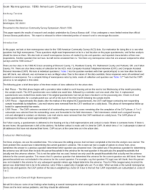
An official website of the United States government
Here’s how you know
Official websites use .gov
A .gov website belongs to an official government organization in the United States.
Secure .gov websites use HTTPS
A lock (
) or https:// means you’ve safely connected to the .gov website. Share sensitive information only on official, secure websites.
-
//
- Census.gov /
- Census Working Papers /
- Item Nonresponse: 1996 American Community Survey
Item Nonresponse: 1996 American Community Survey
Item Nonresponse: 1996 American Community Survey
Introduction
In this paper, we look at item nonresponse rates for the 1996 American Community Survey (ACS) data. Our motivation for doing this is to see what questions had high nonresponse. These questions might need improvement or be in a bad location on the paper questionnaire, and further analysis should be done on them. We also look at overall nonresponse (across all modes) by site and question, and reported characteristics of item nonrespondents. Another question that we have, but will not be answered here is, "Are there any nonresponse rates that are unusual compared to other surveys and the 1990 census?"
There are four sites in the 1996 ACS test consisting of Brevard County, FL; Rockland County, NY; Multnomah County and Portland, OR; and Fulton County, PA. There are also three modes of collection for the ACS: mail, Computer Assisted Telephone Interview (CATI), and Computer Assisted Personal Interview (CAPI). We look at individual questions ( Table 2 has the question numbers with their question/topic) to see how often the item was left blank, was refused, was not known or was an illegal value. Due to the nature of the data available, these responses were all combined and reported as nonresponse. For a compete listing of nonresponse rates by state, mode of collection and question see Table 3 (***note that the CAPI universe is not weighted in this table).
The following gives a brief description of the three modes of data collection for the urban sites.
- Mail Phase -- The Mail phase begins with a prenotice letter mailed to each housing unit on the next to last Wednesday of the month preceding the sample month. The ACS questionnaire was mailed one week later, followed by a reminder card one week after that. A replacement questionnaire was mailed three weeks later if the original questionnaire had not yet been checked in at the processing site. Check-in of mail return questionnaires for a sample panel was cut off at the start of the third month following the sample month.
- CATI Phase -- Approximately five weeks after the mailout of the original ACS questionnaire, the CATI staff began contacting non-responding sample households by telephone. Late mail returns were removed from the CATI workload on a daily basis. This phase of nonresponse follow-up lasted for approximately four weeks.
- CAPI Phase -- The CAPI universe consisted of all outstanding non-response cases remaining after the completion of the CATI phase. A 1 in 3 subsample was selected from the outstanding cases and forwarded to the field interviewers. Field interviewers visited each assigned housing unit and attempted to conduct an interview. Late mail returns were removed from the CAPI workload on a daily basis. The CAPI phase of nonresponse follow-up lasted approximately one month.
For Fulton county, a questionnaire is delivered to the housing unit by a field representative and contact is made if there is someone home. If there is no one home, the questionnaire is left at the address. No further contact is made until it is time for CAPI. At which time a 1 in 3 subsample is taken of all addresses that have not returned their forms. CAPI occurs at the same time as in the urban sites.
Others in Series
Working Paper
Working Paper
Working Paper
Share
Some content on this site is available in several different electronic formats. Some of the files may require a plug-in or additional software to view.
 Yes
Yes
 No
NoComments or suggestions?


Top

